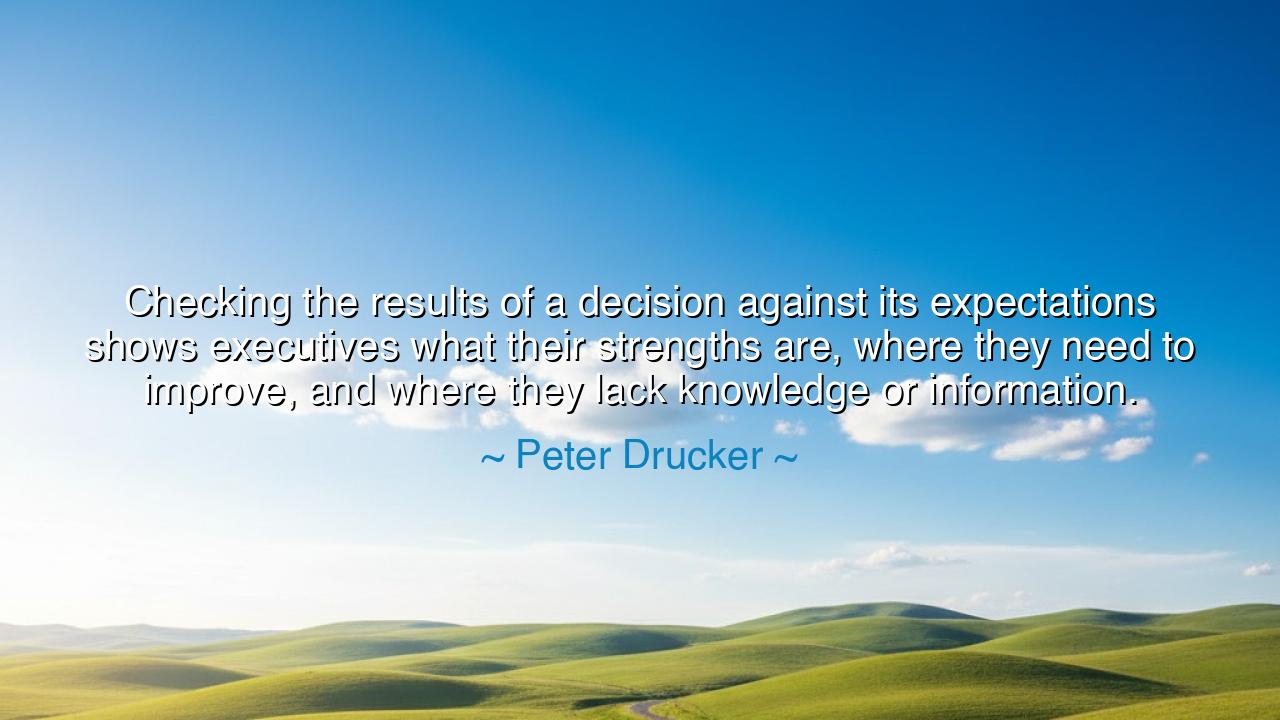
Checking the results of a decision against its expectations shows
Checking the results of a decision against its expectations shows executives what their strengths are, where they need to improve, and where they lack knowledge or information.






Peter Drucker, the father of modern management, once proclaimed with piercing clarity: “Checking the results of a decision against its expectations shows executives what their strengths are, where they need to improve, and where they lack knowledge or information.” In this wisdom lies not only a principle for leaders of commerce, but a teaching for all who walk the path of decision-making. For decisions are the seeds we plant, and results are the harvest we reap. To compare the two is to learn whether our hands sowed wisely or foolishly, and whether we must change the way we till the soil of our lives.
The origin of this wisdom springs from Drucker’s lifelong study of organizations, leadership, and human behavior. He saw that success is not born from chance, but from discipline: the discipline to look backward as well as forward, to measure outcomes against intentions, and to learn without pride or despair. In his eyes, the true leader was not the one who always succeeded, but the one who always learned—who used results not as a crown for glory, but as a mirror reflecting truth.
History provides us with shining examples. Consider Abraham Lincoln in the crucible of the American Civil War. Many of his early generals failed him, their campaigns falling short of expectations. Yet Lincoln did not close his eyes to these failures; he examined them carefully, learning where strategies faltered and where leadership was weak. Through this honest reckoning, he found in Ulysses S. Grant the general who could bring victory. Lincoln’s greatness lay not in blind loyalty to his first choices, but in his willingness to compare expectations and results, and to change course with courage.
So too in business, think of Thomas Edison, who tested thousands of filaments before perfecting the light bulb. Each experiment was a decision; each failure was a result. Rather than despair, Edison compared his expectations with what reality revealed, and in doing so discovered both his ignorance and his progress. His words echo Drucker’s teaching: “I have not failed. I’ve just found 10,000 ways that won’t work.” In this constant measuring of results against expectations, knowledge was born, and invention triumphed.
The meaning of Drucker’s words is heroic and humbling. He reminds us that we are not gods who decree success with a word, but mortals who must wrestle with reality. Our expectations may be high, but reality is often unyielding. To compare the two requires humility: the humility to admit mistakes, to confess ignorance, and to embrace the truth that growth comes not from pretending we are always right, but from learning when we are wrong. Strengths are revealed when expectations and results align; weaknesses are exposed when they do not. Both are gifts, for both teach us how to grow.
The lesson for us, children of tomorrow, is clear: do not shrink from testing your choices against reality. Do not cling to pride when results fall short, nor to arrogance when they succeed. See every decision as a teacher. Let success show you your strengths, let failure show you your weaknesses, and let both guide you toward wisdom. For in this discipline lies mastery—not only of business, but of life itself.
Practical steps can be taken. After each important decision, write down your expectations: what you thought would happen, why you thought it would, and how success would look. Then, when results arrive, compare them with your record. Ask: where was I right? Where was I blind? What knowledge did I lack? Do this faithfully, and you will grow in judgment, humility, and skill. You will transform your life into a constant school of wisdom, where no choice is wasted, and every outcome is a lesson.
So let Drucker’s words echo as an eternal counsel: “Checking the results of a decision against its expectations shows what our strengths are, where we must improve, and where we lack knowledge.” Carry this truth in your heart. For the wise are not those who never err, but those who learn from every decision, until wisdom itself becomes their strength and understanding their crown.






AAdministratorAdministrator
Welcome, honored guests. Please leave a comment, we will respond soon